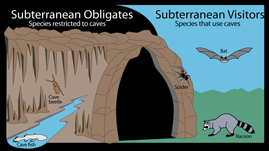Teachers' Domain - Digital Media for the Classroom and Professional Development
User: Preview


This interactive adapted from the Kentucky's Natural Heritage: An Illustrated Guide to Biodiversity, illustrates how karst landscapes contribute to the formation of caves and cave systems. Caves and Karst Occurrences also takes a look at the five specific types of cave-dwellers: Stygobites, Troglobites, Trogloxenes, Troglophiles, and Accidentals. These five groups are made up of all of the different species that can be found in and around caves
If you are like most people, you probably think caves are full of raccoons, bears and all kinds of creepy insects and spiders. If so, you wouldn’t be wrong, but that is not all you will find in caves. Stepping into a cave can feel like landing onto a different planet!
Before discussing the variety of species that can be found in caves, it is important to define what a cave is and where they can be found. Generally, caves are defined as openings in the ground that are natural, large enough for humans to enter, and extend beyond the light zone. Most of Kentucky’s caves are formed in karst landscapes, which are areas formed from constant weathering and movement of limestone. Caves, sinkholes, and underground streams are characteristics of karst landscapes.
The type of cave-dwellers found in a cave depends on the rock type, stream type and origin of the cave. Overall though, there are five specific types of cave-dwellers: Stygobites, Troglobites, Trogloxenes, Troglophiles, and Accidentals. These types of cave-dwellers include raccoons and insects as one may expect. But, they also include fish with no eyes, salamanders, and bats in frighteningly large numbers. All of these species have their own reasons for needing to live in a cave for some part of their lives. For example, the blind fish cannot survive outside of the cave because it cannot see. Animals like raccoons use caves for a safe resting place during the day. Bats use caves for most of their life cycle, only leaving to feed.
Kentucky has a substantial cave system that supports one of the most diverse sub-terranean populations in the world. With the number of caves still to explore, the number of sub-terranean species found in Kentucky is sure to increase.
Give students a list of questions you developed from the interactive. Have them view the interactive in small groups or as individuals and complete the questions.
OR
Break the class up into five groups. Assign each group one of the five types of cave-dwellers and have them review that section of the interactive. Come back to class as a whole and have each group teach about their section of the interactive.
 Loading Standards
Loading Standards